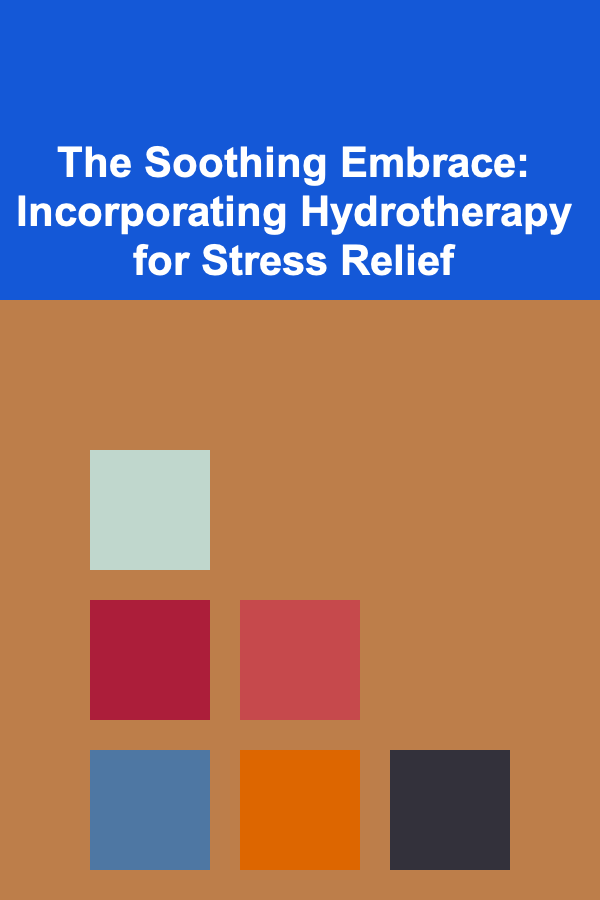
The Soothing Embrace: Incorporating Hydrotherapy for Stress Relief
ebook include PDF & Audio bundle (Micro Guide)
$12.99$10.99
Limited Time Offer! Order within the next:

In the relentless current of modern life, stress has become an almost ubiquitous companion. It whispers anxieties in our ears, tightens our muscles, and clouds our judgment, eroding our well-being silently but persistently. While the causes of stress are multifaceted and often deeply ingrained in our societal structures, the need for effective, accessible, and holistic coping mechanisms has never been more urgent. Among the ancient remedies finding renewed scientific validation, hydrotherapy stands out as a powerful, yet often underutilized, tool in the arsenal against stress. From the gentle caress of warm water to the invigorating shock of a cold plunge, water, in its myriad forms and temperatures, possesses an inherent capacity to soothe the mind, relax the body, and rejuvenate the spirit. This comprehensive exploration delves into the profound ways hydrotherapy can be integrated into daily life to mitigate stress, offering not just a temporary reprieve but a path towards sustained mental and physical equilibrium.
Understanding the Pervasive Nature of Stress
Before diving into the therapeutic potential of water, it's crucial to grasp the true impact of stress on the human system. Stress is not merely a psychological state; it is a complex physiological response designed by evolution to help us survive perceived threats. In a primal context, this "fight or flight" mechanism, involving the release of hormones like adrenaline and cortisol, was essential for quick action. However, in contemporary society, these threats are rarely life-threatening but rather chronic---deadlines, financial worries, relationship conflicts, information overload. Our bodies, however, often react as if facing a saber-toothed tiger.
The Physiological Toll of Chronic Stress
- Nervous System Imbalance: Chronic stress keeps the sympathetic nervous system (SNS) on high alert, hindering the parasympathetic nervous system (PNS), responsible for "rest and digest," from doing its job effectively. This imbalance leads to persistent tension and anxiety.
- Hormonal Dysregulation: Elevated cortisol levels suppress the immune system, disrupt sleep, and can contribute to weight gain, particularly around the abdomen. Adrenaline surges can increase heart rate and blood pressure, straining the cardiovascular system.
- Musculoskeletal Tension: The body's natural response to stress is to brace for impact, leading to muscle tightening, especially in the neck, shoulders, and back. This can manifest as chronic pain, headaches, and reduced mobility.
- Digestive Issues: When the body is in "fight or flight" mode, digestion is deprioritized, leading to symptoms like irritable bowel syndrome (IBS), indigestion, and changes in appetite.
- Cardiovascular Strain: Sustained high blood pressure and heart rate increase the risk of heart disease, stroke, and other cardiovascular problems over time.
- Impaired Immune Function: Chronic cortisol release can suppress the immune system, making the body more susceptible to infections and slowing down healing processes.
The Psychological and Emotional Burden
Beyond the physical, stress erodes our mental and emotional landscapes:
- Anxiety and Depression: Persistent stress is a significant risk factor for developing generalized anxiety disorder, panic attacks, and depressive episodes.
- Cognitive Impairment: Stress can affect concentration, memory, decision-making, and problem-solving abilities, leading to feelings of overwhelm and inadequacy.
- Irritability and Mood Swings: The constant state of tension makes individuals more prone to anger, frustration, and emotional volatility, impacting relationships.
- Sleep Disturbances: The mind races, the body remains tense, making it difficult to fall asleep, stay asleep, or achieve restorative deep sleep.
- Loss of Interest and Motivation: Over time, chronic stress can lead to burnout, characterized by emotional exhaustion, cynicism, and a reduced sense of personal accomplishment.
Given this extensive list of detrimental effects, finding sustainable and effective ways to manage stress is not a luxury, but a fundamental necessity for holistic well-being. This is where hydrotherapy, with its profound physiological and psychological benefits, offers a beacon of hope.
The Essence of Hydrotherapy: Water as a Healer
Hydrotherapy, at its core, is the therapeutic use of water in any form---liquid, solid (ice), or vapor (steam)---and at various temperatures and pressures. It is a practice as old as civilization itself, revered by ancient Egyptians, Greeks, Romans, and Japanese cultures for its healing properties. Hippocrates, the father of modern medicine, advocated for water treatments, while civilizations built elaborate bathhouses that served as centers for health, relaxation, and social interaction.
Core Principles and Mechanisms of Action
The efficacy of hydrotherapy stems from several key principles that interact synergistically to promote relaxation and stress reduction:
- Temperature (Thermal Effects): This is perhaps the most obvious and potent aspect.
- Warm/Hot Water: Causes vasodilation (widening of blood vessels), increasing blood flow to muscles and organs. This helps in muscle relaxation, pain relief, and removal of metabolic waste products. The warmth also stimulates the release of endorphins, natural painkillers and mood elevators, and promotes the activation of the parasympathetic nervous system, inducing a state of calm. It mimics the body's natural state before sleep.
- Cool/Cold Water: Initially causes vasoconstriction (narrowing of blood vessels) followed by a rebound vasodilation as the body tries to warm itself. This "vascular gymnastics" stimulates circulation, reduces inflammation, and can boost alertness and mood through the release of norepinephrine and dopamine. Cold exposure also activates the vagus nerve, a key component of the parasympathetic system, promoting resilience to stress.
- Contrast Therapy: Alternating between hot and cold water creates a powerful pumping action in the circulatory system, enhancing detoxification, reducing swelling, and invigorating the body and mind.
- Buoyancy (Mechanical Effects): Water's ability to defy gravity has profound implications. When submerged, the body's weight is significantly reduced, alleviating pressure on joints, muscles, and the spine. This creates a sensation of weightlessness, which is inherently relaxing and allows muscles to decompress, reducing tension.
- Hydrostatic Pressure: The pressure exerted by water on the body increases with depth. This pressure can assist in circulation, reduce swelling (edema) by encouraging fluid return to the lymphatic system, and support the respiratory system by making exhalation slightly more challenging and inhalation easier, promoting deeper breathing.
- Sensory Stimulation: The sound of flowing or bubbling water, the tactile sensation on the skin, and even the visual appeal of a serene aquatic environment contribute to a calming sensory experience. Essential oils or bath salts can further enhance this through olfaction.
- Psychological Impact: Beyond the physiological, the ritual of hydrotherapy provides a dedicated time for self-care, a break from daily demands, and an opportunity for mindfulness. The feeling of being enveloped by water can be deeply comforting and nurturing, fostering a sense of security and peace.
By harnessing these principles, hydrotherapy offers a multi-faceted approach to stress relief, addressing both the physical symptoms and the mental state associated with chronic stress.
Incorporating Hydrotherapy for Stress Relief: Practical Applications
The beauty of hydrotherapy lies in its versatility and accessibility. Many forms can be enjoyed in the comfort of your own home, requiring minimal investment beyond your existing bathroom facilities. Others offer a more immersive experience in professional settings.
1. The Soothing Warm Bath: A Timeless Ritual
Perhaps the most accessible form of hydrotherapy, a warm bath is a quintessential tool for unwinding. The ideal temperature for relaxation is typically between 98°F (37°C) and 104°F (40°C), warm enough to feel comforting but not so hot as to cause overheating or discomfort.
- Mechanism for Stress Relief: Warm water triggers vasodilation, increasing blood flow to the skin and muscles. This helps relax tense muscles, alleviate aches and pains, and promote overall muscle relaxation. The warmth also signals to the brain that it's safe to enter a state of rest and digest, shifting the nervous system from sympathetic (fight or flight) to parasympathetic (rest and repair). The buoyancy of water lightens the body, reducing gravitational pressure on joints and muscles, which further aids in physical relaxation. The dedicated time spent in a bath enforces a pause, a moment of intentional detachment from stressors.
- Enhancing the Experience:
- Epsom Salts (Magnesium Sulfate): Dissolving 1-2 cups of Epsom salts in bathwater can boost the relaxing effects. Magnesium is a crucial mineral involved in over 300 biochemical reactions in the body, including muscle and nerve function, blood glucose control, and blood pressure regulation. Many people are magnesium deficient. Soaking in an Epsom salt bath allows for transdermal absorption of magnesium, which can help calm the nervous system, reduce muscle cramps and soreness, and improve sleep quality.
- Essential Oils: A few drops of therapeutic-grade essential oils can transform your bath into an aromatic sanctuary. Lavender is renowned for its calming and sleep-inducing properties. Chamomile (Roman or German) is excellent for soothing anxiety. Bergamot can uplift mood while promoting relaxation. Ylang-Ylang helps reduce nervous tension and promote feelings of joy. Always dilute essential oils with a carrier oil (like jojoba or almond oil) or an unscented bath gel before adding to water, as oils and water don't mix and undiluted oils can irritate the skin.
- Bath Bombs & Milks: Many commercially available bath bombs contain effervescent ingredients, essential oils, and skin-softening agents, adding to the sensory pleasure. Milk baths, made with powdered milk, oatmeal, or colloidal oats, are excellent for soothing dry or irritated skin while providing a gentle, calming effect.
- Atmosphere: Dim the lights, light some candles, play soft instrumental music or nature sounds, and ensure privacy. Consider a comfortable bath pillow for neck support.
- Duration and Frequency: Aim for 15-30 minutes. Even 10 minutes can be beneficial. Incorporate a warm bath into your evening routine 2-3 times a week, especially before bed, to signal to your body that it's time to wind down.
2. Invigorating Showers: Quick Stress Busters
For those short on time or without a bathtub, showers offer a rapid yet effective form of hydrotherapy.
- Warm Showers: A warm shower quickly eases muscle tension, opens pores, and can wash away the day's physical and mental grime. The continuous flow of water provides a gentle massage-like sensation, promoting relaxation.
- Contrast Showers (Scottish Shower): This technique involves alternating between hot and cold water. Start with a comfortable warm temperature for 2-3 minutes, then switch to cool or cold water for 30-60 seconds. Repeat this cycle 3-5 times, always ending with cold.
- Mechanism for Stress Relief: The rapid change in temperature creates a "vascular gymnastics" effect, causing blood vessels to constrict and then dilate. This invigorates circulation, stimulates the lymphatic system (aiding in detoxification), and enhances oxygen delivery to tissues. Psychologically, the initial shock of cold water triggers a mild stress response, followed by a profound sense of invigoration and mental clarity. Regular practice can improve adaptability to stress and boost resilience. It also stimulates the vagus nerve, which is central to the body's rest-and-digest system and directly impacts stress regulation.
- Aromatherapy in the Shower: Place a few drops of eucalyptus or peppermint essential oil on the shower floor (away from the drain) or on a washcloth hung over the showerhead. The steam will diffuse the aroma, creating a spa-like, respiratory-cleansing experience.
- Duration: A warm shower can be as short as 5-10 minutes. Contrast showers usually take 5-10 minutes for the full cycle.
3. Saunas and Steam Rooms: Heat Therapy for Deep Relaxation
These are popular features in gyms and spas, offering deep heat penetration that promotes relaxation and detoxification.
- Sauna (Dry Heat): Uses dry heat, often generated by heated rocks, with temperatures ranging from 150°F to 195°F (65°C to 90°C).
- Mechanism for Stress Relief: The intense dry heat causes rapid sweating, helping to release toxins and metabolic waste products. It significantly increases heart rate and blood flow, mimicking a light cardiovascular workout, yet the body remains in a state of relaxation. The heat deeply penetrates muscles, releasing tension and alleviating soreness. The quiet, enclosed environment also encourages introspection and mindfulness, providing a mental escape. Regular sauna use has been linked to improved cardiovascular health and reduced risk of all-cause mortality, contributing to overall well-being and thus stress resilience.
- Steam Room (Wet Heat/Humid): Operates at lower temperatures, typically 110°F to 120°F (43°C to 49°C), but with 100% humidity.
- Mechanism for Stress Relief: The moist heat is excellent for respiratory health, helping to clear sinuses and airways, which can be beneficial for those whose stress manifests as respiratory tightness. Like saunas, steam rooms induce profuse sweating for detoxification and promote muscle relaxation. The humid environment can feel less oppressive to some and offers a gentle, enveloping warmth. The warmth and humidity combine to open up pores, clean the skin, and create a deeply soothing experience.
- Usage Tips:
- Limit sessions to 10-20 minutes.
- Stay hydrated before and after.
- Cool down gradually afterwards, perhaps with a cool shower or by sitting in a cooler area.
- Listen to your body; exit if you feel lightheaded or unwell.
4. Whirlpools and Hot Tubs: Targeted Massage and Relaxation
Combining warm water with pulsating jets, hot tubs and whirlpools offer a unique form of hydro-massage.
- Mechanism for Stress Relief: The warm water expands blood vessels, promoting circulation and muscle relaxation. The directed jets of water provide a deep tissue massage, targeting specific areas of tension (e.g., neck, shoulders, lower back). This mechanical action helps break down knots in muscles and stimulate blood flow to areas that are often tight due to stress. The buoyancy also helps relieve pressure on joints, making it ideal for those with musculoskeletal pain. The combination of heat, massage, and weightlessness creates a profoundly relaxing experience, both physically and mentally. The gentle sounds of bubbling water can also contribute to a meditative state.
- Enhancements: Many modern hot tubs have features like mood lighting, built-in sound systems, and even aromatherapy diffusers to enhance the relaxation experience.
- Considerations: Ensure proper water hygiene and chemical balance. Limit sessions to 15-20 minutes, especially if the water temperature is high. Hydrate well.
5. Cold Plunges and Ice Baths: The Invigorating Chill
While seemingly counterintuitive for stress relief, deliberate cold exposure is gaining significant traction for its profound benefits on mental resilience and physical recovery.
- Mechanism for Stress Relief:
- Vagal Nerve Stimulation: Cold exposure is a powerful activator of the vagus nerve, which plays a central role in the parasympathetic nervous system. Activating the vagus nerve helps lower heart rate, promotes relaxation, and improves the body's ability to switch from a sympathetic (stress) state to a parasympathetic (rest) state.
- Neurotransmitter Release: Cold water immersion triggers the release of norepinephrine, a neurotransmitter that can improve mood, focus, and energy. It also boosts dopamine levels, leading to feelings of pleasure and motivation.
- Stress Adaptation: Regular, controlled cold exposure teaches the body to adapt to acute stressors. By intentionally putting the body in a temporary, safe stressor (cold), you train your physiological and psychological systems to respond more calmly and effectively to everyday stressors, building resilience.
- Reduced Inflammation: Cold therapy is well-known for its anti-inflammatory properties, which can help alleviate pain and muscle soreness, often associated with chronic stress.
- How to Incorporate:
- Start Slowly: Begin with cold showers (as described in contrast showers). Gradually increase duration and decrease water temperature.
- Ice Baths/Cold Plunges: Fill a bathtub with cold water and ice. Start with 1-2 minutes immersion, gradually increasing to 5-10 minutes as tolerated. Focus on deep, controlled breathing (e.g., Wim Hof method breathing) to manage the initial shock.
- Frequency: 2-4 times a week can yield significant benefits.
- Important Note: Consult your doctor before beginning cold therapy, especially if you have heart conditions, high blood pressure, or are pregnant.
6. Swimming and Aquatic Exercise: Moving Meditation
Engaging in aquatic activities offers a unique blend of physical exercise and meditative calm.
- Mechanism for Stress Relief:
- Low-Impact Exercise: The buoyancy of water reduces the impact on joints, making swimming an excellent full-body workout for people of all fitness levels. Exercise itself is a potent stress reliever, releasing endorphins and reducing stress hormones.
- Meditative Repetition: The rhythmic strokes of swimming, combined with the sensation of water against the skin and the muffled sounds underwater, can induce a meditative state. It encourages mindfulness and being present in the moment, diverting attention from stressful thoughts.
- Cooling Effect: For some, the coolness of pool water is inherently refreshing and can help calm an overstimulated nervous system.
- Ai Chi & Water Yoga: These forms of aquatic exercise combine slow, flowing movements, deep breathing, and mindfulness in water, specifically designed to reduce stress, improve balance, and increase flexibility.
- Accessibility: Public pools, community centers, and specialized aquatic therapy centers offer opportunities for swimming and water-based classes.
7. Foot Baths: A Simple Yet Effective Remedy
The feet contain numerous nerve endings and reflexology points connected to various organs and systems in the body. A simple foot bath can offer significant stress relief.
- Mechanism for Stress Relief: Soaking the feet in warm water dilates blood vessels, improving circulation throughout the body and drawing blood away from the head, which can alleviate tension headaches and a feeling of "overthinking." It provides localized relaxation and can be surprisingly effective at calming the entire nervous system.
- Warm Foot Bath: Use warm water (around 100-105°F or 38-40°C).
- Additives: Epsom salts, essential oils (peppermint for invigoration, lavender for relaxation), or even a handful of marbles at the bottom for a gentle foot massage.
- Duration: 15-20 minutes.
- Contrast Foot Bath: Alternate soaking feet in warm water for 3-5 minutes, then cold water for 30-60 seconds. Repeat 3-5 times, ending with cold. This stimulates circulation and can be energizing.
- Benefit: Foot baths are incredibly easy to incorporate, even during a busy day, and require minimal equipment. They are perfect for a quick reset when feeling overwhelmed.
8. Compresses and Wraps: Targeted Relief
Applying hot or cold compresses and wraps can provide targeted relief for specific areas of the body where stress manifests.
- Hot Compresses: A cloth soaked in hot water and applied to tense muscles (e.g., neck, shoulders, lower back) promotes vasodilation, increases blood flow, and relaxes muscle fibers. This is excellent for relieving muscle spasms and soreness associated with stress-induced tension.
- Cold Compresses: A cloth soaked in cold water or an ice pack wrapped in cloth applied to areas of inflammation or pain can reduce swelling and numb nerve endings, providing immediate relief. For headaches often caused by stress, a cold compress on the forehead or back of the neck can be very effective.
- Full Body Wraps: In professional settings, full body wraps (hot or cold) can be used to promote deep relaxation or stimulation. At home, a simpler version might involve a warm, damp towel wrap around the abdomen for digestive comfort during stress.
Creating Your Home Hydrotherapy Sanctuary and Ritual
The true power of hydrotherapy for stress relief lies not just in the water itself, but in the ritual and intention you bring to the experience. Transforming your bathroom into a personal sanctuary can amplify the benefits.
Setting the Ambiance
- Lighting: Dim overhead lights. Use candles (ensure safety) or soft LED lights to create a warm, calming glow. Avoid harsh, bright illumination.
- Sound: Play calming music (nature sounds, instrumental, ambient) or simply embrace the silence. The sound of water itself can be meditative.
- Scent: Utilize diffusers with calming essential oils (lavender, frankincense, bergamot, chamomile) or add them safely to your bathwater. A scented candle can also work.
- Temperature: Ensure the room temperature is comfortable, neither too hot nor too cold, to prevent additional stress on the body.
- Cleanliness: A clean, uncluttered bathroom fosters a sense of peace and order, conducive to relaxation.
- Privacy: Ensure you won't be disturbed. Put your phone on silent or in another room. This is your time.
Cultivating a Mindful Ritual
Hydrotherapy is an opportunity to practice mindfulness and self-compassion.
- Preparation: Before stepping into the bath or shower, take a few deep breaths. Set an intention for your hydrotherapy session -- perhaps to release tension, clear your mind, or simply rest.
- Sensory Engagement: Pay attention to the sensations. Feel the warmth or coolness of the water on your skin. Notice the sound of the water. Breathe in the aromas. Observe how your muscles respond and begin to relax.
- Body Scan: As you soak or stand under the water, perform a mental body scan. Start from your toes and slowly move up, noticing any areas of tension. Consciously invite those areas to relax with each breath.
- Deep Breathing: Focus on slow, deep breaths. Inhale slowly through your nose, expanding your belly, and exhale even more slowly through your mouth. This activates the vagus nerve and promotes relaxation.
- Visualization: Imagine the water washing away your stress, worries, and negative emotions, leaving you feeling cleansed and renewed.
- Post-Hydrotherapy Care: Once your session is complete, gently pat yourself dry. Apply a nourishing body lotion or oil to lock in moisture and continue the self-care. Drink a glass of water or herbal tea to rehydrate. Allow yourself a few minutes of quiet contemplation or gentle stretching before resuming other activities. This transition helps to maintain the state of calm you've cultivated.
Tip for Consistency:
Schedule your hydrotherapy sessions. Treat them like important appointments with yourself. Consistency is key to unlocking the long-term benefits of stress reduction and improved well-being.
Professional Hydrotherapy and Spa Environments
While home hydrotherapy is wonderfully effective, professional spa and wellness centers offer specialized treatments that can further deepen the stress-relief experience.
- Vichy Showers: You lie on a wet table while multiple showerheads rain down water, often combined with massage. This provides an invigorating and relaxing full-body water massage.
- Hydrotherapy Tubs: These specialized tubs often have numerous jets positioned to target specific muscle groups, offering a more intense and precise hydro-massage than a typical hot tub.
- Kneipp Therapy: Originating from Sebastian Kneipp, this involves systematic hot and cold water applications, often in specialized pools or baths, designed to stimulate circulation, boost the immune system, and reduce stress. It's a structured form of contrast therapy.
- Thalassotherapy: Utilizes seawater, marine climate, and marine products (algae, mud, sand) for therapeutic purposes, often found in coastal spa resorts. The mineral content of seawater adds another layer of benefit for relaxation and skin health.
- Flotation Tanks (Sensory Deprivation Tanks): While not strictly hydrotherapy in the traditional sense, these tanks, filled with a shallow solution of highly concentrated Epsom salts, allow for complete buoyancy. The sensory deprivation combined with weightlessness can induce profound relaxation, deep meditative states, and significant stress reduction.
Professional settings offer the benefit of expert guidance, specialized equipment, and an environment entirely dedicated to relaxation, allowing for deeper surrender to the therapeutic process.
Integrating Hydrotherapy into a Holistic Stress Management Plan
Hydrotherapy is a powerful component, but it flourishes best as part of a broader, holistic approach to stress management. Its benefits are amplified when combined with other well-being practices:
- Mindfulness and Meditation: Hydrotherapy naturally lends itself to mindfulness. Integrating formal meditation practices, even just 10-15 minutes daily, can train your mind to respond more calmly to stressors outside of the water.
- Deep Breathing Exercises: Conscious breathing techniques (e.g., diaphragmatic breathing, box breathing) can be practiced anywhere, anytime, to immediately calm the nervous system.
- Regular Physical Activity: Exercise, whether it's swimming, yoga, walking, or strength training, is a proven stress reducer, releasing endorphins and helping to metabolize stress hormones.
- Balanced Nutrition: A diet rich in whole foods, fruits, vegetables, and lean proteins supports overall brain health, gut health, and energy levels, contributing to better stress resilience. Avoid excessive caffeine and sugar, which can exacerbate anxiety.
- Adequate Sleep: Hydrotherapy, particularly warm baths, can significantly improve sleep quality. Prioritizing 7-9 hours of quality sleep nightly is fundamental for stress recovery and cognitive function.
- Connecting with Nature: Spending time outdoors, whether in a park, forest, or by a body of water, has been shown to lower cortisol levels and improve mood.
- Social Connection: Nurturing meaningful relationships provides emotional support and can buffer the effects of stress.
- Professional Support: For chronic or severe stress, anxiety, or depression, seeking guidance from a therapist or counselor is crucial. Hydrotherapy can be a valuable complement to therapy, not a replacement.
By viewing hydrotherapy as one vital thread in the tapestry of self-care, individuals can weave together a comprehensive strategy for building resilience, mitigating stress, and fostering a life of greater peace and well-being.
Important Precautions and Considerations
While hydrotherapy is generally safe and beneficial, certain precautions are necessary to ensure a positive and safe experience:
- Consult Your Doctor: Before embarking on any new hydrotherapy regimen, especially if you have pre-existing medical conditions such as heart disease (e.g., high or low blood pressure, arrhythmias), diabetes, epilepsy, open wounds, skin conditions, or are pregnant. Temperature extremes, particularly cold plunges or very hot baths, can pose risks for certain individuals.
- Hydration: Always drink plenty of water before, during (if possible, in saunas/steam rooms), and after hydrotherapy sessions, especially those involving heat, to prevent dehydration.
- Temperature Extremes:
- Hot Water: Avoid water that is excessively hot, as it can cause lightheadedness, overheating, or exacerbate certain conditions. Pregnant women should avoid very hot baths or hot tubs due to the risk of increasing core body temperature.
- Cold Water: Introduce cold exposure gradually. Listen to your body and do not push yourself beyond comfortable limits, especially in the beginning. Never force yourself into cold water if you feel unwell.
- Slipping Hazards: Be mindful of wet surfaces in bathrooms, showers, and around tubs. Use non-slip mats.
- Additives: Use essential oils and bath salts sparingly and ensure they are suitable for skin contact. Some oils can cause irritation or are not recommended during pregnancy. Always dilute essential oils before adding them to bathwater.
- Duration: Adhere to recommended session durations. Prolonged exposure to extreme temperatures can be detrimental.
- Listen to Your Body: If you feel dizzy, nauseous, or uncomfortable at any point, exit the water or change the temperature immediately.
- Hygiene: Ensure that hot tubs, public pools, and home bathtubs are clean and properly maintained to prevent infections.
The Continuous Flow of Well-being
In a world that often demands constant productivity and relentless adaptation, the simple act of immersing oneself in water can be a revolutionary act of self-care. Hydrotherapy, with its deep historical roots and increasingly understood scientific basis, offers an accessible, versatile, and profoundly effective pathway to stress relief. From the familiar comfort of a warm bath to the invigorating challenge of a cold plunge, each interaction with water provides an opportunity to release physical tension, calm the nervous system, and restore mental clarity.
By consciously incorporating hydrotherapy into daily routines---whether through a deliberate evening bath ritual, an energizing morning contrast shower, or regular visits to a sauna or pool---individuals can actively rebalance their nervous system, reduce inflammation, improve sleep, and foster a greater sense of peace and resilience. It is more than just a momentary escape; it is a commitment to nurturing one's inner landscape, allowing the soothing embrace of water to wash away the burdens of stress and pave the way for a life lived with greater ease, presence, and vitality. Embrace the power of water, and discover its profound capacity to heal, comfort, and rejuvenate your mind, body, and spirit.

How to Choose the Right Storage Solutions for Your Needs
Read More
How to Plan for Healthcare Costs Without Overspending
Read More
How to Sell Used Books on Amazon: A Comprehensive Guide
Read More
How to Set Up a Cat Litter Box Area That Minimizes Odor
Read More
How to Use a Travel App to Keep Everything in One Place
Read More
How To Understand the Philosophy of Value
Read MoreOther Products

How to Choose the Right Storage Solutions for Your Needs
Read More
How to Plan for Healthcare Costs Without Overspending
Read More
How to Sell Used Books on Amazon: A Comprehensive Guide
Read More
How to Set Up a Cat Litter Box Area That Minimizes Odor
Read More
How to Use a Travel App to Keep Everything in One Place
Read More